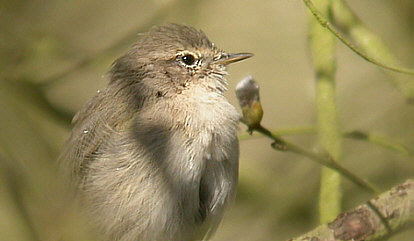 |
RED-THROATED DIVER
Gavia stellata
Kessingland - 1st (1 S), 3rd (1
N, 1 S), 4th (2 N), 7th (1 N), 8th (1 N), 9th (1 N), 10th (1 N), 11th
(1 S), 14th (1 N), 19th (1 N), 29th (1 N).
Monthly total = 13 (10 N, 3 S).
GREAT CRESTED GREBE
Podiceps cristatus
Noted past Kessingland on the 29th
(1 S).
FULMAR
Fulmarus glacialis
Ness Point - 3rd (8 N), 17th (4 N), 18th (1 N), 21st (4
N).
Kessingland -
1st (7 N, 2 S), 2nd (1 N), 3rd (5 N), 4th (241 N, 4 S), 5th (102
N, 23 S), 6th (16 N, 1 S), 7th (27 N, 1 S), 8th (6 N), 10th (8 N), 11th
(36 N, 2 S), 12th (15 N, 1 S, 1 o/s), 13th (121 N, 5 S), 14th (48 N,
1 S), 15th (11 N, 1 o/s), 16th (4 N, 3 S), 17th (11 N), 18th (11 N,
2 S), 19th (30 N), 20th (14 N), 21st (20 N), 22nd (5 N, 1 S), 23rd (14
N), 24th (7 N, 1 S), 26th (13 N, 4 S), 27th (15 N), 28th (5 N), 29th
(3 N), 30th (1 N, 1 S, 2 o/s).
Highest Day Count = 245 (241 N, 4 S) on the 4th.
Monthly total = 850 (794 N, 52 S, 4 o/s).
On the 20th a disorientated individual flew south over Budgens, Kessingland.
GANNET
Morus bassanus
Ness Point
- 3rd
(50 N), 6th (1 N), 16th (1 N), 17th (5 N), 19th (10 N), 21st (4 N, 1
S).
Kessingland -
1st (34 N), 3rd (48 N), 4th (83 N), 5th (19 N, 1 S), 6th (43
N, 1 S), 7th (27 N), 8th (4 N), 9th (15 N), 10th (20 N), 11th (3 N),
12th (4 N, 1 S), 13th (13 N, 1 S), 14th (12 N, 1 S), 15th (7 N), 16th
(10 N), 17th (16 N), 18th (31 N), 19th (74 N, 1 S), 20th (43 N), 21st
(31 N), 21st (61 N), 22nd (5 N, 1 S), 23rd (19 N), 24th (11 N), 26th
(2 N), 27th (5 N), 29th (6 N, 1 S), 30th (1 N, 2 S).
Highest Day Count = 83 (83 N) on the 4th.
Monthly total = 657 (649 N, 8 S).
CORMORANT Phalacrocorax carbo
Gunton - 16th (1).
Leathes Ham - Seven roosting throughout.
Kessingland
- 7th (3 N), 9th (1 N),
13th (1 N, 4 S), 14th (1 S), 17th (1 S), 28th (1 S).
SHAG Phalacrocorax aristotelis
Immature birds were along Lake Lothing 5th (1) and 6th (2). Both were
roosting at Leathes Ham on the evenings of the 11th-14th. On the 13th
they left the roost at 06.55.
GREY HERON Ardea cinerea
One flew NE out to sea at Kessingland 10th @ 17:05 .
WHITE STORK Ciconia ciconia
One flew over Yarmouth Library at 10:30 before continuing south
over Gorleston on the 23rd. Two were later seen at Minsmere midday.
The lone bird in our area was quite likely to be one of the free flying
birds from Thrigby Hall wildlife park which frequently wander locally
in the spring. The two at Minsmere however were a pair which wandered
around south Suffolk and north Essex throughout the day. One of them
had been ringed in a Belgian zoo.
GREYLAG GOOSE Anser anser
At least three pairs are nesting at Leathes Ham.
CANADA GOOSE Branta canadensis
Four were at Leathes Ham on the 6th, with two on the 13th, though they
don't appear to be breeding there yet.
Kessingland -
2nd (2 S), 9th (2 N, 5 S), 12th (2 S), 14th (2 N).
BRENT GOOSE Branta bernicla bernicla
Ness Point
- 12th (2 N).
Kessingland -
4th (1 S), 7th (6 N, 5 S), 8th (1 S), 12th (2 N), 22nd (5 S),
29th (1 N).
EGYPTIAN GOOSE Alopochen aegyptiacus
Leathes Ham currently holds at least two pairs, though with no obvious
signs of nesting yet. However, the now regular pair in Lowestoft Harbour
were seen mating on the 6th so it appears they are going to attempt
to raise another brood after the first attempt failed in February.
SHELDUCK Tadorna tadorna
Kessingland -
1st (1 S), 4th (4 S), 9th (2 S), 11th (1 N), 13th (1 S), 16th
(2 S), 17th (1 S), 20th (1 N), 21st (3 S), 23rd (2 S), 27th (2 S), 29th
(4 S), 30th (5 N, 3 S).
WIGEON
Anas penelope
Kessingland -
6th (4 S).
TEAL Anas crecca
Kessingland -
6th (1 N).
GADWALL Anas strepera
Kessingland
- 30th(2 S).
SHOVELER Anas clypeata
Kessingland - 13th (4 N), 22nd (5 S), 23rd (2 N), 29th
(2 S).
COMMON SCOTER Melanitta nigra
Kessingland -
1st (3 N, 2 S), 3rd (3 N), 4th (17 N), 5th (3 N), 6th (5 N),
9th (10 N), 10th (2 N), 17th (2 N), 20th (1 N), 26th (12 N), 27th (9
N), 28th (5 N), 30th (4 N).
VELVET SCOTER Melanitta fusca
Kessingland -
6th, eight flew north accompanied by three Common Scoter and
one Teal.
GOLDENEYE Bucephala clangula
One was on Leathes Ham on the 4th-18th.
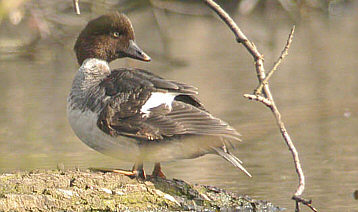 |
|
Goldeneye - Leathes Ham - April 2003 - ©Andrew Easton |
RED-BREASTED
MERGANSER Mergus serrator
Kessingland -
1st (1 S), 7th (1 S), 15th (1 S), 21st (1 N).
BLACK KITE Milvus migrans
One flew south over Breydon Water being mobbed by crows 29th.
HEN HARRIER Circus
cyaneus
One ringtail was seen at Kessingland Sewage Works 5th; Carlton Marshes
17th (male).
ROUGH-LEGGED BUZZARD Buteo lagopus
One flew north over Haddiscoe Marshes 28th.
PEREGRINE Falco peregrinus
A real rarity in Lowestoft itself one was seen over Lowestoft Cemetery
20th, circling low before heading east mid-morning.
OYSTERCATCHER Haematopus
ostralegus
Ness
Point
- 12th (1 S).
Kessingland -6th
(1 N), 8th (1 S), 11th (2 N), 12th (3 S), 13th (4 S), 14th (1 N), 16th
(1 S), 20th (1 N), 22nd (1 N), 24th (3 S), 26th (1 S), 27th (1 S), 29th
(1 S), 30th (1 N, 1 S).
AVOCET Recurvirostra avosetta
33, Burgh Castle Flats 17th. Stunning birds!!!
RINGED PLOVER Charadrius hiaticula
Kessingland
Beach -
9th (8).
GOLDEN PLOVER Pluvialis apricaria
One was at the Hopton/Gorleston Golf Course
16th; Carlton Marshes 20th (18).
GREY PLOVER Pluvialis squatarola
Kessingland
- 6th (1 N), 19th (3 N), 26th (1 S).
SANDERLING Calidris alba
Noted
on Kessingland Beach 16th (2).
PURPLE SANDPIPER Calidris maritima
Last
recorded at Ness Point 14th (2).
TURNSTONE Arenaria interpres
Four
were present on Lowestoft South Pier 21st, one of which is looking rather
smart.
Kessingland Beach - 1st (3), 6th (15), 9th (9), 11th (9).
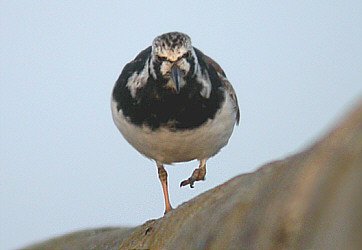 |
|
Turnstone - Lowestoft South Pier - April 21, 2003 - ©Robert Wilton |
SANDERLING
Calidris albe
Kessingland
Beach - 16th (2), 22nd (1)
RUFF Philomachus pugnax
Burgh
Castle Flats -
17th (29).
BLACK-TAILED GODWIT Limosa limosa
An
impressive 193 were on Burgh Castle Flats 17th.
BAR-TAILED GODWIT Limosa lapponica
One
arrived in off the sea over Lowestoft North Denes, with five south at
Ness Point 21st.
Noted
past Kessingland on the 26th (1 S), 27th (1 S).
SPOTTED REDSHANK Tringa erythropus
Three
were on Burgh Castle Flats 17th.
WHIMBREL Numenius phaeopus
Noted
Kessingland 18th (3 N), 21st (1 S), 22nd (1 N, 1 S), 23rd (2 N), 26th
(1 N), 29th (1 N); Peto Marsh, Carlton Marshes 18th; Lowestoft North
Denes 27th; Corton 27th.
CURLEW Numenius arquata
Kessingland
- 10th (1 N), 27th (3 S), 28th (3 S), 29th (2 S), 30th (1 N, 1 S).
GREEN SANDPIPER Tringa ochropus
Presumably
the same bird was noted over Carlton Marshes and Fisher Row 18th. Two
were at Lound Water Works 21st.
COMMON SANDPIPER Actitis hypoleucos
One
was at Mutford Lock, Lake Lothing 5th.
TURNSTONE Arenaria interpres
Kessingland Beach -
1st (3), 6th (15), 9th (9), 11th (9).
ARCTIC SKUA Stercorarius parasiticus
Noted north past Kessingland 13th (16:50 pale phase adult), 14th (06:55
dark phase adult), 29th (17:30 dark phase).
POMARINE SKUA Stercorarius pomarinus
One flew north past Kessingland 27th @ 07:00.
GREAT SKUA Catharacta skua
Noted past Kessingland 11th (N at 17:10), 13th (N @ 17:30), 18th (N
@ 6:48).
MEDITERRANEAN GULL Larus melanocephalus
An
adult and two second summer birds in breeding plumage were at Ness Point
8th. What were presumably the same two second summer birds were seen
on Leathes Ham 9th where a first-summer was present 13th.
Kessingland - 10th (ad. + 2nd-summer N), 11th (ad. S),
12th (ad. + 2nd-summer N), 13th (3 ad. + 2nd-summer N), 20th (2nd-summer
N), 21st (ad. + 2nd-summer N), 22nd (ad. + 2nd-summer N), 23rd (2nd-summer
N).
LITTLE GULL Larus minutus
Seven that
flew north past Burgh Castle 17th included 6 stunning adults.
HERRING
GULL Larus argentatus
The
leucistic bird pictured below, superficially resembled a first-winter
Iceland Gull L. glaucoides. Present on the 5th this first-summer
individual, had a pale but clear tail band, a distinct secondary bar,
pale inner primary window, and pale outer primaries with irregular darker
markings. The long primary projection is an artifact of worn tertials
(the bare quills can be seen in the picture). The pale iris, extensive
pale bill base and very pale pink legs are also a result of the lack
of normal pigmentation.
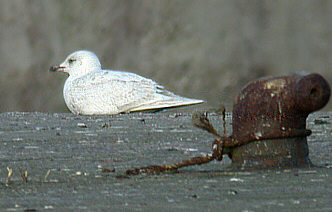 |
|
Leucistic Herring Gull - Lowestoft Harbour - April 5, 2003 - ©Robert Wilton |
GLAUCOUS
GULL Larus hyperboreus
The
long staying first-year bird was back in Lowestoft Harbour on the 6th,
15th, 16th and 20th.
GREAT
BLACK-BACKED GULL Larus marinus
A
pure white first year gull was roosting in Lowestoft Harbour on the
evening of the 15th was at first thought to be Herring Gull. The plumage
was much fresher than the earlier bird, with no darker markings evident
at all, even in flight. The bill was strikingly black against the white
plumage, with a small paler area at the base, much darker than the earlier
bird. The eye also appeared quite dark and it was clearly not an albino.
It was present again on the evenings of the 17th and 18th. Immature
gulls can be hard to tell apart at times but this bird with all possible
diagnostic plumage features completely lacking poses more problems than
most.
KITTIWAKE
Rissa tridactyla
Kessingland
-
1st (2 N, 1 S), 2nd (31 S), 3rd (10 N), 4th (9 N, 2 S), 5th (5 N),
6th (13 N), 7th (7 N, 1 S), 8th (1 N, 1 S), 9th (5 N, 2 S), 10th (4
N, 1 S), 12th (11 N, 3 S), 13th (31 N, 6 S), 14th (12 N, 13 S), 15th
(23 N, 4 S), 16th (5 N), 17th (14 N, 1 S), 18th (24 N, 1 S), 19th (4
N), 20th (26 N), 21st (10 N, 9 S), 22nd (3 N, 3 S), 23rd (13 N), 24th
(1 S), 26th (9 N), 27th (2 N, 3 S), 28th (3 N, 5 S), 29th (4 N, 5 S),
30th (5 N, 14 S).
Highest
Day Count =
37
(31 N, 6 S) on the 13th.
Monthly total =
362 (254 N, 108 S).
SANDWICH
TERN Sterna sandvichensis
Ness
Point -
16th (4 N).
Kessingland
-
2nd (1 S), 3rd (1 N), 4th (1 N), 10th (1 N), 11th (1 N), 12th (3
N), 13th (4 N), 15th (11 N), 16th (9 N, 1 S), 17th (9 N), 18th (3 N),
20th (1 N), 21st (3 N), 23rd (4 N), 24th (5 N), 26th (9 N), 27th (8
N, 2 S), 29th (5 S), 30th (5 N).
Highest
Day Count = 11 (11 N) on the 15th.
Monthly total = 87 (78 N, 9 S).
COMMON TERN Sterna hirundo
One
was seen along Lake Lothing 16th.
Kessingland
- 4th (2 N), 13th (2 N), 14th (2 N), 15th (4 N), 16th (1 N), 18th (3
N), 20th (1 N), 21st (3 N), 22nd (1 N), 23rd (10 N), 24th (2 N), 26th
(4 N), 27th (3 N), 28th (2 N), 29th (3 N), 30th (3 N, 4 S).
Highest
Day Count = 10 (10 N) on the 23rd.
Monthly total = 50 (46 N, 4 S).
ARCTIC TERN Sterna paradisaea
One flew north past Ness Point on the evening of the 15th.
LITTLE TERN Sterna albifrons
At 07:20 on the 23rd a Little Tern flew south past Kessingland (the
first sighting of the year from this location) there after on the 24th
(1 N), 29th (1 S), 30th (3 N, 5 S).
AUK sp. Alcidae
Kessingland
- 4th (8 N, 1 S), 14th (1 N).
TURTLE DOVE Stretopelia turtur
One flew in off the sea over the Lowestoft North Denes 27th before
continuing west.
CUCKOO Cuculus canorus
Singles noted at Beccles Marshes 16th; Fisher Row 16th, 20th, 21st;
Lound 21st.
TAWNY OWL Strix aluco
Two were calling in Gunton Woods 11th.
SHORT-EARED OWL Asio flammeus
One Carlton Marshes until the 22nd. Two northbound individuals flew
over Kessingland Beach on the 22nd @ 07:45 and on the 29th @ 14:15.
BARN OWL Tyto alba
One was at Kessingland by-pass 17th; Carlton Marshes 29th (2).
COMMON SWIFT Apus apus
Earlier than usual with the first seen over Lowestoft Lighthouse
25th (2); Lowestoft, Corton and Burgh Castle 27th (several); Oulton
Broad 27th (30); Sussex Road, Lowestoft 27th (3); Kessingland Beach
28th (2 S).
KINGFISHER Alcedo atthis
One was at Lound Water Works 17th.
SAND MARTIN Riparia riparia
Noted Kessingland Beach 5th (1 N); Kessingland Sewage Works 13th
(5), 15th (10); Corton 13th (4), 18th (30).
SWALLOW Hirundo rustica
Noted at Kessingland Sewage Works 12th (2 N), 13th (5), 15th (5); Rookery
Park Golf Course 15th (4); Lowestoft North Denes Campsite 16th (6);
Lound 17; Corton 18th (1 S); Lowestoft South Pier 21st.
HOUSE MARTIN Delichon urbica
Noted at Corton 18th (1 N); Kessingland Sewage Works 20th (1); Lound
Water Works 21st (3); Oulton Broad 27th (10); Kessingland 28th (1 S).
TREE PIPIT Anthus trivialis
Noted at Hopton/Gorleston Golf Course 16th (1 S); Kessingland Sewage
Works 17th (2).
MEADOW PIPIT Anthus pratensis
Twenty were at Hopton/Gorleston Golf Course 16th, with forty on
the North Denes Campsite the same day. Definitely worth a mention is
the massive movement off this species in Holland on the 15th at the
migration watchpoint of Breskens, Zeeuws-Vlaanderen (Zeeland). "In
the first 5 hours of daylight a new day (and year!) record of 367,590
Meadow Pipits was noted. Best 15 minutes were between 10.45 and 11a.m.,
when over 43,000 were counted, with earlier and later quarters also
over 40,000 birds" [Hofland, R. EuroBirdnet 2003].
 |
|
Meadow Pipit - Lowestoft North Denes - April 2003 - ©Robert Wincup |
YELLOW
WAGTAIL Motacilla (flava) flavissima
Noted at Kessingland Sewage Works 15th, 27th (2), 26th (1); Hopton/Gorleston
Golf Course 16th (2 S); Lowestoft North Denes 16th, 17th, 27th (2).
BLUE- HEADED WAGTAIL Motacilla (flava) flava
One was present on the filter beds at Kessingland Sewage Works 17th-21st.
GREY WAGTAIL Motacilla cinerea
One was at Kessingland 5th.
WHITE WAGTAIL Motacilla alba alba
One was at Kessingland sewage works 5th, with two on the 6th.
BLACK REDSTART Phoenicuros ochruros
Noted along Lake Lothing 16th (1st-summer male); Harris Avenue,
Lowestoft 22nd; Lowestoft North Denes 28th-29th.
COMMON REDSTART Phoenicurus phoenicurus
Female Harris Avenue, Lowestoft 4th.
WHINCHAT Saxicola rubetra
Stunning males seen at Camp's Heath, Oulton 20th; Gunton 25th (2);
Lowestoft North Denes 26th.
NORTHERN WHEATEAR Oenanthe oenanthe
Noted at Kessingland 2nd (1), 14th (1), 16th (1), 17th (1), 18th
(2); Lowestoft North Denes 11th (1), 16th-17th (1), 20th (2), 26th (7),
27th (6); Gunton 15th (1); Corton 16th (1), 27th (2), 30th (3).
RING OUZEL
Turdus torquatus
With Norfolk knee deep in Ring Ouzels during April they remained amazingly
scarce in Suffolk. The first in our area was a female on Gorleston golf
course on the evening of the 16th. Thereafter noted at Fisher Row 20th
(1); Kessingland Levels 22nd (male); Belton 23rd (2); Blundeston 23rd
(male).
FIELDFARE Turdus pilaris
Recorded at Jay Lane, Lound 15th (7); Lound Water Works 20th (40),
21st (15); Beccles Marshes 18th (70+), 24th (70+).
REDWING Turdus iliacus
Recorded at Gunton 15th, 16th (4); Hopton/Gorleston Golf Course 16th
(4); Fisher Row 19th (5), 20th (30); Beccles Marshes 18th (3).
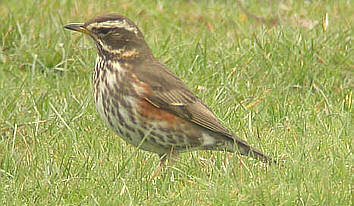 |
|
Redwing
- Fisher Row - April 19, 2003 - ©Andrew Easton
|
CETTI'S
WARBLER Cettia cetti
Noted at Leathes Ham 4th-21st (1); Carlton Marshes 18th (5+); Hall Road,
Oulton; and Oulton Broad. More surprisingly individuals were heard singing
at Corton on the 25th and along Peto Way, Lowestoft on the 30th which
along with an upsurge in numbers at Minsmere RSPB reserve to the south
is suggestive of a recent immigration of new birds.
SEDGE WARBLER Acrocephalus schoenobaenus
Noted at Kessingland 15th (1), 19th (1); Carlton Marshes 18th (3); Oulton
Broad 19th (1).
REED WARBLER Acrocephalus scirpaceus
Noted at Carlton Marshes 18th (1); Oulton Broad 20th (1).
GRASSHOPPER WARBLER Locustella naevia
Noted
at Fisher Row 21st, 22nd (2); Carlton Marshes 22nd (4), 29th (3). With
coastal records rare one singing briefly from Kessingland Cliff 26th
is particularly noteworthy.
LESSER WHITETHROAT Sylvia curruca
The
first of the year was singing in Leathes Ham on the 17th and Gunton
22nd-26th (1).
WHITETHROAT Sylvia communis
Noted
on the 16th at Hopton/Gorleston Golf Course (1), Lake Lothing (1), Kessingland
sewage works (3), Beccles Marsh Trail (2), Carlton Marshes (1).
BLACKCAP Sylvia atricapilla
Noted
at Kessingland 5th (2), 16th (5); Leathes Ham 6th (1); Lowestoft North
Denes 13th (1); Gunton 13th-15th. Widespread at the end of the month.
SPOTTED FLYCATCHER Muscicapa
striata
One
was at Corton disused railtrack early morning on the 30th.
One of the birds of year to date was a Siberian Chiffchaff which was in full song at Leathes Ham, Lowestoft from the 4th-21st. Drawing quite a crowd at times it favoured the flooded scrub area opposite the Cafe at the car park entrance ranging as far as the tennis courts. On the 18th it was singing in the flooded trees at the far end of the car park early morning. Later on it was feeding along the foot/cyclepath embankment adjoining the tennis courts. On occasions it would disappear for hours.
The plumage was generally uniform grey/brown. The flight feathers were fresh and had a slight but noticeable greenish tinge to them. This green wash was most noticeably on the rump/uppertail coverts. It had a very small pale area at the base of the lower mandible, which was exaggerated in strong sunlight, especially when singing. The legs were dark brown.
Like
most birds the appearance changed depending on lighting. In dull light
the bird appeared cold grey, typical of what you'd expect a tristis
to look like. However, in better light the plumage became much warmer
as the bird basked in the sun.
The bird sang its heart out during its stay giving many observers the
chance to hear its song for the first time. Its vocalizations were certainly
the most interesting characteristics of this race. The song was absolutely
fantastic, starting off with a short spell of stuttered 'chiff's'
before breaking into a descending series of Willow Warbler like 'wee-choo'
notes interspersed with the odd 'chiff' note again. It was enjoyed
by everybody who heard it.
On the rare occasions the bird called it was likened to that of a 'lost
chick' or maybe a plaintive Bullfinch. Care was called for when locating
the bird due to the presence of a newly hatched brood of ducklings,
unless there was a flock of Siberian Chiffchaffs!!! What
an excellent bird this was and who knows how far we'll have to travel
to get another in the field burst of Sibe. Chiffchaff in full song!!!
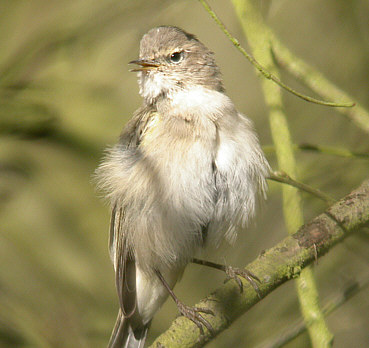 |
|
Siberian
Chiffchaff - Leathes Ham - April 2003 - ©Robert
Wincup
|
WILLOW
WARBLER Phylloscopus trochilus
Singing birds seen at Leathes Ham/Normanston Park 5th-6th (2); Gunton
13th (2), 15th-16th (5); Jay Lane, Lound 15th (1).
FIRECREST Regulus
ignicapilla
Noted at Kessingland sewage works 11th, 12th (2); and
Flycatcher Lane, Lowestoft 21st.
JACKDAW Corvus monedula
Migrants
seen at Lowestoft North Denes 17th (20 SE); Corton 18th (3 S).
CARRION CROW Corvus corone
Migrants
seen over Lowestoft North Denes 17th (30 SE), 18th (17 E out to sea
+ 11 N).
BRAMBLING Fringilla montifringilla
One was along Marsh Lane, Kessingland 20th.
SISKIN Carduelis
spinus
Noted
at Hopton/Gorleston Golf Course 16th (1 S); Lowestoft North Denes 16th
(4 S); Burgh Castle 27th (1 N).
LESSER REDPOLL Carduelis cabaret
Twelve
flew south at Corton 18th.
CROSSBILL Loxia curvirostra
Fourteen flew south over Dip Farm football pitch, Gunton 15th. Six were
at Lound Water Works 21st.